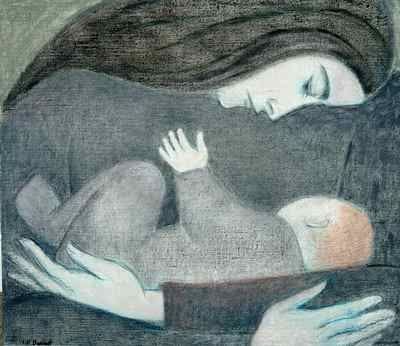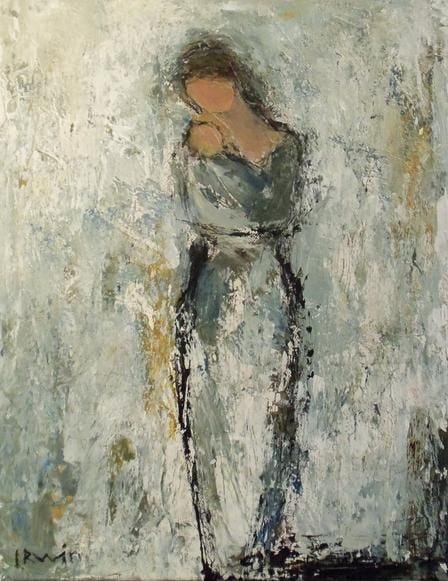My understanding of what “mothering” is, or could be, was hugely influenced by this passage in the Tao Te Ching (CHXXV). The artwork that follows amplifies it.
There was something complete and nebulous
Which existed before the Heaven and Earth,
Silent, invisible
Unchanging, standing as One,
Unceasing, ever-revolving,
Able to be the Mother of the World.
That last line, “Able to be the mother of the world,” has become a kind of mantra for me. It inspires me to identify with and live larger than what I appear to be individually. I turn to this felt-sense of self when I want to have a clearer, purer, more expansive sense of who I am at heart, when all that’s extraneous is removed.
The words refer to the Tao, that which is all-pervading, all-embracing, unchanging and unceasing. It’s the thing that evolves, supports, nurtures, protects, and provides space for its “children,” all individual being. But I take them in a more personal way, as something to aspire toward–-as a mother, a writer, a homemaker, artist, citizen. The world has much need of our mothering.
It inspires me to embrace my children in that spirit. To step back and project in some way this more expansive sense of mothering that allows them to feel loved and supported without all the worries and anxieties and criticism and fear that accompany a mere human sense of mothering.
This mothering is not as personal, intense, or myopic. It doesn’t hover, it doesn’t obsess, it doesn’t fret. It frees them “to be,” and is based on an immense sense of trust—in myself, in them, and in the universe at large. In God, or Tao, or some divine presence or higher power that embraces all of us, and gives each of us the capacity to mother each other.
I find this kind of mothering works best when I embrace all around me with the same mothering spirit. Not just my children, but all children, all people, all things—my home, my community, my work—even the individual objects that fill the space around me and the space outside my window. When I’m able to actually feel and identify with that potential, to “be” the “Mother of the World.”
The images in this post capture some of that universal and spiritual kind of Mothering, not only of love, but of unity and wholeness—two in one, and one in two. Two overlapping, enveloping, and yet distinct identities. “Not-two” is the way a Buddhist or Taoist might put it.
The painting by Sikorskaia at the top of the post shows this beautifully. The mother’s body wraps about her breast-feeding infant and fills the whole space with the solid, four-square wholeness of her presence. Her dark head is bent, attentive, surrounded by a halo of light-colored flesh. Her arms, open hand, and bend back form another circle, encircling the first. Her feet tenderly touch each other, and with the raised and lowered legs form a triangle of unity, the base upon which the mother sits.
She is grounded and centered, while the child is loose in her arms, able to move and to feed freely, but blending with the mother’s flesh, showing how closely knit they are even while separate beings. The dominant lines creating this painting are round, curved, circling each other. Mother and child are one in body and being. Two in one. One in two.
The following image by Barnet is similar. Mother and child completely fill the space and overflow it. They are facing each other, mirror reflections of each other. She sees herself in her child, the child sees itself in the mother. Her hands are wrapped around the child, but open, as is the child’s hand, reaching up toward the mother, toward its other surrounding self.
Will Barnet, Mother and Child,1993-2006
The painting by Irwin below also creates the powerful feeling of oneness and unity. Here we see the indistinct features and form of mother and child surrounded by a shadowy, indistinct background. The vertical figure is centered and reaches top to bottom, nearly bisecting the page. Clearly it shows two in one, one in two. The soft, indistinct edges of the form feather into the background, soft and permeable. The Mother and Child are one with each other and one with the surrounding environment. The whole painting is a study of unity and wholeness.
“Madonna & Child” by Holly Irwin
Two-ness is more evident in the next paintings.
“Just Out of the Sea” Joaquin Sorolla, 1915
Here, we see this close unity of mother/child as well as the foreshadowing of their separation. The surrounding sea, symbolizing the womb and oneness, as well as the towel flung over and around mother and child, unite them. But all that takes place behind them foreshadows separation. The layered waves and wayward boat, the deep shadows and strong light also denote two-ness: the pairing of opposites. It seems a beautiful, tender, but fleeting moment in time. Unlike the first three images which seem iconic, timeless and eternal.
“Beach Treasures” by Jeffrey T. Larson (1999)
This last painting by Larson is probably my favorite among these five-–for so many reasons. But first and foremost because it captures that golden glow of late afternoon on the beach, when the strong light casts shadows so deep and dark. The light shimmers around them and through them, uniting them, and revealing a transparency that we see in the figure’s back-lit clothing.
Mother and child are clearly two distinct individuals now. Still, the touching heads and hands form a circle of unity and closeness. Even the shadows at their feet flowing upward through the two figures form a second circle of unity. We still have two-in-one and one-in-two, even while the separate individuals are clearly defined.
There is something nostalgic about this painting. A tender sweetness underscored by the foreshadowing of separation as the two move apart from each other and this singular moment is lost in passing time. We cannot stop passing time, but we can capture it in these sweet moments, and preserve it in our art and our memories.
And I suppose that’s why I find all these paintings so powerful and profound. They capture universal and primal experiences we all have shared at one time or another in our journey from one to two and back again.
Mothering, I’ve learned, is a capacity that anyone can embrace: man, woman, child. You don’t have to be a mother, or have children of your own, to mother the world, to feel that oneness, or two-in-one. When we adopt that stance, all things become our children to nurture, cherish, support, love—to help bring to their full potential.
Here’s wishing you all a lovely day of “mothering.”









I enjoyed reading this. One main reason is the art interpretation. I am no artist so seeing them somewhat how you see them was interesting. I also love the idea of "mothering the world"
I'm glad you enjoyed reading it. Thank you so much for letting me know. Does my heart good. I'm also glad you liked my comments on the artwork, it's something I love doing, trying to figure out why a piece of art moves me the way it does